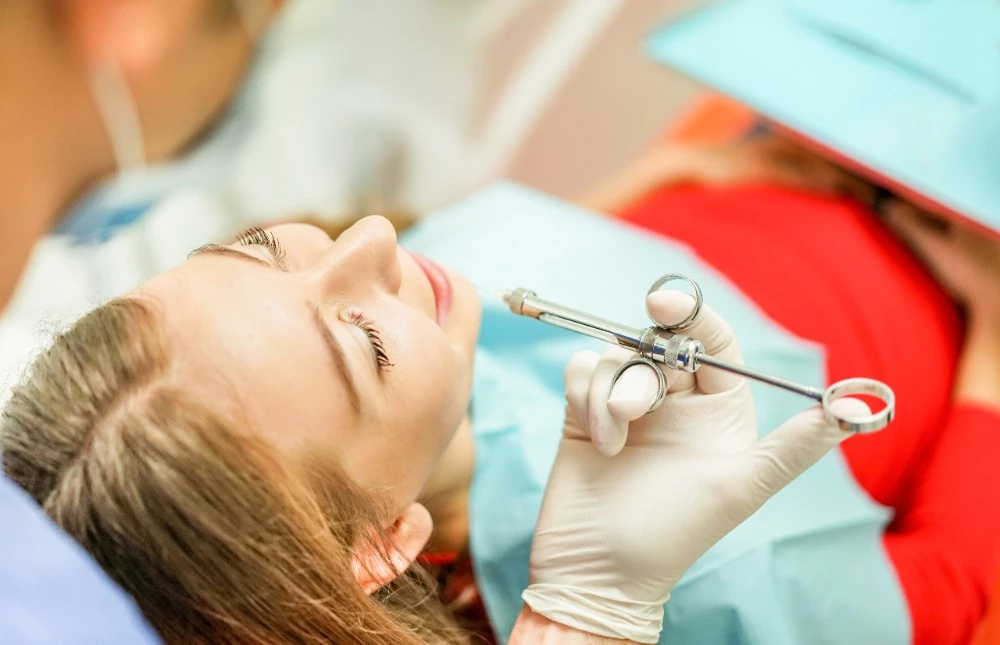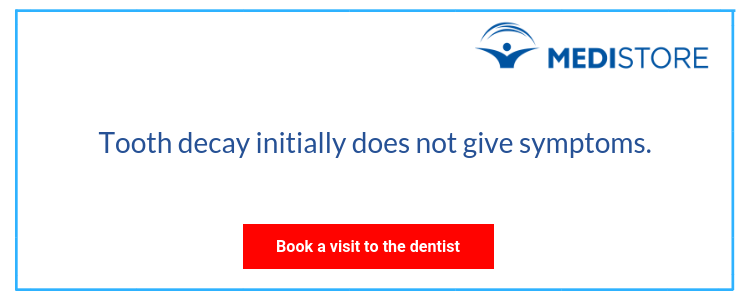Where does dental caries come from?
Dental caries involves demineralisation and breakdown of a tooth’s hard tissues, leading to cavities and numerous complications. This condition is an acquired disease and the hereditary factor plays no significant role in this case. What contributes to its initiation is susceptibility of dental tissues, dental plaque (bacteria), substrate (providing ideal conditions for bacteria) and time. These four factors represent the main causes of caries - explains Patryk Kononowicz, a dental professional at Medicover. As he adds, it is the co-occurrence and interaction of the above factors that leads to cavities.
Symptoms of dental caries
To cut a long story short, tooth decay manifests itself as a cavity in your tooth. First – pain and struggle at home; in the end – drill bits, drilling, devitalisation, or even extraction of a tooth. First of all, to save a carious tooth, we cannot put off our dental appointments. Secondly, we should take regular care of our oral hygiene and, even if we experience no symptoms, attend regular dental check-ups.
Discolouration, sensitivity of the teeth to temperature (especially to cold) and sweet products, as well as gum bleeding, may indicate that dental caries is developing. However, the initial stages of a carious lesion produce no symptoms. Therefore, it is so important to frequently have your teeth checked up at the dentist’s and follow the preventive recommendations. If detected early enough, dental caries requires no drilling and this process can be reversed, concludes Patryk Kononowicz, a dental practitioner.
Prevention of dental caries
As indicated by the contemporary dental literature, the individual prevention of caries should be a three-step measure. The first two levels of this caries prevention concern our childhood. The third one, also known as the traditional level, is linked to adulthood. It involves systematic removal of any bacteria that form on the tooth’s surface. And this should be done not only by regular and thorough brushing, flossing and rinsing with a mouthwash at home, but also through hygienisation procedures at dental surgeries.
Reinforcement of the enamel with fluoride, proper hygiene leading to elimination of cariogenic bacteria, as well as a sugar-low diet will provide perfect protection against the potential problems, stresses Patryk Kononowicz, a dental practitioner.
As important aspect of caries prevention is its individual orientation. Such preventive measures may include check-ups to remove dental plaque, reduction in the frequency of sugar consumption, and application of age-appropriate hygienisation agents. In individuals from a high risk group for caries, the essential preventive procedures include: sealing of grooves and fissures on the teeth’s surface, as well as application of antibacterial preparations with chlorhexidine (an organic chemical compound; a synthetic antiseptic – editorial note).
Proper oral hygiene and professional prevention, tailored individually to each patient, may provide 100% protection against dental caries. It is worth asking your dentist what to do and how to take care of your teeth to avoid new cavities, emphasises Patryk Kononowicz, a dental practitioner.

Reference kit on caries prevention
As underlined by our specialist, proper oral hygiene really constitutes a substantial part of our success in counteracting caries. Surely, nobody needs convincing that the prevention is always better than cure, so it is worth putting great emphasis on our oral hygiene.
Oral hygiene
To maintain proper oral hygiene, all dental practices perform the so-called hygienisation. It encompasses tartar removal (the so-called scaling), sandblasting and fluoridation. The first of the above procedures involves removal of hard deposits of tartar from under and over the gums, using an ultrasonic scaler. Tartar results, amongst others, in lowering and exposure of tooth necks, which may cause the teeth to become loose and fall out (periodontitis). Sandblasting, on the other hand, simply involves cleaning the teeth’s surface from build-up, dental plaque and any discolourations caused by coffee, tea, cigarettes, etc., using the so-called sandblaster. The last stage of hygienisation in a dental practice involves fluoridation. It involves brushing and rubbing fluoride solutions, gels and varnishes into the teeth or applying special foam to the teeth’s surface.
How to brush our teeth?
Apart from hygienisation in dental practices, it is essential to take daily care of our oral hygiene at home. And here, it is very important to thoroughly brush all the parts of our teeth with fluoride toothpaste – two or three times a day. Brushing is all the more significant because, in individuals with low susceptibility to caries, it may constitute a sufficient caries prevention measure. When it comes to brushing, it should be noted that not all brushing techniques are correct. In this regard, it is crucial to obtain individual dental advice on how to brush our teeth effectively and safely taking into account our age, state of dentition and periodontium. As far as the brushing time is concerned, it is best to brush our teeth shortly after a meal, since high fluoride concentration inhibits demineralisation and boosts mineralisation. Another reliable and indispensable method is to brush our teeth immediately before going to bed, when – as a result of decreased saliva production, fluoride ions last in the mouth for longer and exert anti-caries action. The most suitable toothbrushes are those with soft bristles – provided that they are replaced with new ones at appropriate intervals.
As stressed by specialists, fluoride may also be supplied by chewing gums and dental floss for cleaning proximal surfaces. Individuals with active caries may also be treated with fluoride-based varnish, applied every three or six months accordingly.
It is therefore clear from the above that whether or not our smile will be enchanting depends, to a large extent, on ourselves. And regardless of the shape and colour of the teeth we have received from Mother Nature, each smile – if properly and systematically cared for – has the power to enchant. So, let’s do it!
Dental caries vs diet
The allies and enemies of caries prevention in our diet: |
Products that prevent the formation of caries due to to their composition include, for instance:
The enemies of caries prevention: these products contain carbohydrates susceptible to fermentation – consequently they may lead to the formation of organic acids that reduce the oral pH levels and initiation of the cariogenic process. These include:
|





